The bold, the brave the few… Handloaders
For me, this is an exercise an independent study that may, or may not, lead to a practical conclusion. It doesn’t matter, as I like the handloading process and that is often its own reward.
Handloading can be an exercise in production; a way to create optimal combinations of components for a specific application or, in some cases, a way to shoot more and spend less. Handloading can also be a very creative process, which includes original cartridge design or, possibly, a way to feed a firearm that is chambered for an obsolete cartridge.
Considering the belly flopping failure of so many recently introduced niche cartridges, recreating obsolete cartridges from readily available popular cartridges may be a much broader endeavor than one, or even two, might think. No one likes staring at a firearm that won’t go “boom”, because its owner can’t find ammunition.
Some are more… complex than others…
Above left, the case forming/finishing progression from 357 Magnum to 256 Winchester Magnum. Above right, the case forming progression from 357 SIG to 17-357RG.
Back in 2004, I wanted to write a series of articles that would illustrate potential elements of handloading. To that end, a cartridge was designed that cold and fire formed the 357 SIG case to .17 caliber. So we did the drawings, had chamber reamers made, then a set of forming and reloading dies fabricated.
It takes 8 forming dies, inclusive of a full length sizer, length trimming, inside neck drilling, outside neck turning, annealing, and fire forming to make cases without casualties. The finished product generates 3,000 fps from a 10″ closed breech barrel with 25 grain bullets. It is very effective for varmint hunting.
Two firearms were made for the cartridge. Handload development was done with a sleeved barrel SIG P229 and a 10″ barrel Contender. I was never able to get the SIG to cycle, even with a slide machined, crudely, from aluminum. The Contender’s performance was/is truly stellar. Why make this cartridge? Because I could. I am a handloader.
Nice pistol, no ammo – The 256 Winchester Magnum… And so it begins
Recently, I had the pleasure of working with a Bowen Classic Arms Ruger conversion. A stainless steel Blackhawk that began life as a 357 Mag / 9mm Luger convertible, and was fitted for a 256 Winchester Magnum chambered cylinder. The problem was the absence of ammunition or brass.
Reforming brass from an original cartridge is relatively straight forward, but I was not sure of the most cost effective way to approach the project. Make my own forming dies, purchase forming dies, follow the anonymous “wisdom” of social media.
One popular social media suggestion is to run 357 Mag brass through a 30 Luger die. I pulled the drawings for both cases. The 256 Win has been retired from SAAMI, so it is not included in the current drawing publication. Fortunately, I am old and keep three ring binders of SAAMI publications from years gone by, which includes the 256 Win Mag.
Of course I’ve made a comparison table. I heavily rely on tables and photographs to offset my less than fully developed writing skills… as in “Yesterday I were a handloader. Today I are a writer”.
| Cartridge | Headspace Contact Surface |
Shoulder Datum Line ⌀ “ |
Neck ⌀ ” |
Neck Length “ |
Case Length “ |
Case Body At Rim ⌀ “ |
Case Body At Shoulder ⌀” |
| 30 Luger | Shoulder | 0.355 | 0.332 |
0.153 |
0.850 | 0.389 | 0.378 |
| 256 Win Mag | Rim 0.060 | 0.324 | 0.285 |
0.208 |
1.281 | 0.379 | 0.368 |
| 357 Magnum | Rim 0.060 | N/A | 0.379 |
N/A |
1.290 | 0.379 | 0.379 |
Social media expert advice appears to be, “Do not buy dies made for the specific purpose of forming 357 Mag brass into 256 Winchester brass but rather, step one, run a 357 Mag case through a 30 Luger forming die then, step two, run it through a full length 256 Win resizing die. Then trim and anneal. Anneal like crazy. Anneal like you never have before. Some say anneal before, some say during the process, some say after, but the important thing is to anneal. I guess because no one likes case neck tension? Yes, that is a paragraph rife with sarcasm.
No, I don’t know why all the annealing, unless dead soft brass is the objective. Annealing is an as needed process to restore work hardened brass to its original state. Dead soft brass is never an objective, because dead soft brass does not cold form correctly and cases lose their bullet retaining neck tension.
Additional advice from the same Internet sources is to never use nickle plated brass, because cases will split and eat reloading dies.. like a lion on a warthog. OK. Maybe I paraphrased and exaggerated a tiny bit, but essentially… And yet ammo makers load plated brass routinely. Maybe they anneal?
The 30 Luger as a forming die was eliminated
The 30 Luger forming die approach was not my selection for several reasons. I considered the one reduction step of 0.045″, followed by a sizer die 0.047″ second and final reduction step, too large of a reduction increment that results is a good number of formed brass casualties. A problem not solved by slopping on gobs of case lube, automatic transmission fluid, turkey fat… or annealing.
The 30 Luger’s too short neck length, and difference in shoulder geometry, improperly forms the case neck or shoulders, and forces the case body outward. The 30 Luger’s 0.010″ larger diameter, where the body intersects the shoulder, allows the forming case to go oversize. Conclusions supported by experimentation, not theoretical.
Roll my own eliminated…
Often, because I am frugal, and don’t like to wait 6 months, I make my own forming and oddball loading dies. That requires some low carbon, 7/8-14 threaded rod from Granger for the die body, a rougher reamer, a headspace gauge, and a couple of soft 1/2″-20NF bolts.
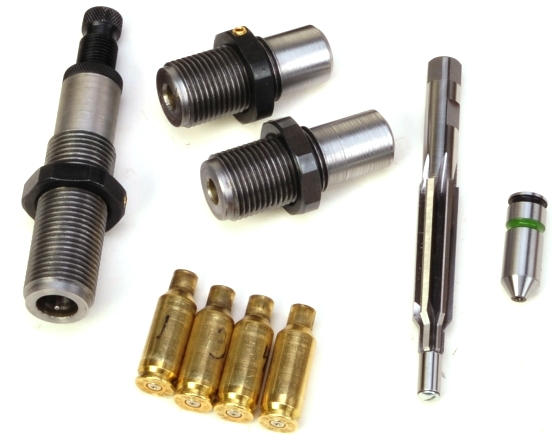
In the case of the 256 Win Mag forming dies, it would have been easy. Reamed 3 forming dies, then drilled the neck opening in three progressively larger steps, maybe 0.310″, 0.335, 0.360″. A commercial, full length sizer die would finish the job.
I could not locate a reamer that wasn’t special order (AKA long wait), or a rental that didn’t have absurd add on charges. I caved, and bought the two Redding forming dies made for this specific application. Prices vary greatly with source. MidwayUSA at time of purchase was $120 each, but Grafs was under $80 each. I did not buy the recommended trim die as I have other powered bench equipment that turns brass into shorter brass.
So I bought/made some gauges to test process
My objective was to get 100% yield on effort, assemble quality cartridges, optimize performance velocity/accuracy, and have brass that survives at least 10 cycles. I could not measure work progress and/or output without the ability to measure dimensions.
A Wilson cartridge gauge helped a good deal within the reloading process. It is a precise drop gauge that facilitates a min-max range check of headspace, in this case rim thickness, and case length.
The gauge’s interior is deliberately cut oversize to prevent contact with any other surface that would interfere with accurate headspace and case length readings. Subsequently, this gauge will not check reference shoulder location or case diameters.
Both ends of the gauge are relieved with a horizontal groove that passes across the inserted cartridge. On the rim end, the depth of the groove provides a 0.005″ min-max acceptable headspace, rim thickness, variation. The case mouth end has a groove to provide a min-max 0.010″ point of reference.
As pictured above, PMC brass inserted into the gauge is resting below the lower checking groove surface, so it is below minimum thickness and a rejected case.
The revolver’s cylinder as a key arbiter
The 256 Winchester chamber drawing indicated a min-max spec of 0.061″ – 0.068″ between the cylinder and the breech face of the frame. The subject Blackhawk’s gap measured 0.065″. The 256 Win Mag rim thickness spec is 0.060″ +0.000/-0.010″. The parent case in this exercise, the 357 Mag, is essentially the same at 0.060″ +0.000/-0.011″. Subsequently, the gap between a rim face and breech face could fall between 0.005″ – 0.015″ and still be in spec..
Pulling out the very thin, out of spec, PMC brass as unusable, I found there was a high yield of 0.056″ to 0.058″ 357 Mag brass when drawing from Winchester, Hornady, R&P, and Starline brass inventory. As a result, the gap between rim and revolver breech face from coming production would range from 0.007″-0.009″.
Cold Forming with all Redding dies

| Step | Neck ⌀ | Shell Holder |
| 357 Mag | 0.382 | Standard |
| #1 Form | 0.342 | Standard |
| #2 Form | 0.315 | Standard |
| FL Sizer | 0.286 | Standard |
If finished handloads did not seat down to the rim when inserted in the cylinder, they would either prevent the cylinder from rotating beyond the loading gate or jam elsewhere on breech face during cylinder rotation. The ammo passed the Wilson cartridge gauge for headspace and case length, so I dropped a sample from first production into the cylinder and… Hmm..
The round did not seat to the rim, but rather protruded approximately 0.040″ and would not allow the cylinder to rotate beyond the loading gate. Not a good sign.
My first thought was that the case neck was formed too far forward, and was improperly acting as the headspace determining surface. I needed a gauge to check shoulder position relative to the rim.
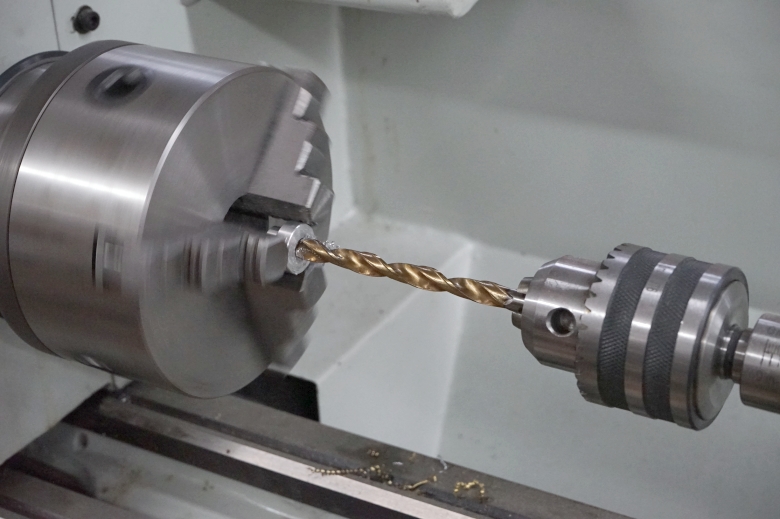
I generally use a Hornady headspace comparator for quick readings. Unfortunately the shoulder diameter at the datum line on the 256 Winchester Magnum is 0.324″, and Hornady does not make a comparator bushing to that dimension.
Hornady does offer blank headspace bushings, with an 0.188″ pilot hole, but I had none in the shop and I could not locate one on line. However, the anvil that holds the bushing is the same size as the anvil that holds the Hornady bullet comparator bushing.
I had lots of duplicate small bore comparator bushings on hand, So I chucked one of the 0.224″ bushings in the lathe and opened the hole with a “P” 0323″ drill. A little machine waggle, a little reamer clean up, and the result was an 0.324″ bushing opening. Yay for me! As, yes, that is a three jaw chuck and, yes, that is a very long drill, far, far away from the work.
I checked cases, and measured from shoulder datum line to rim face and they measured a relatively uniform 1.022″. The case spec is 1.031″ +0.000/-0.015″, so a minimum length of even 1.007″ would meet the drawing spec. Yet the case was protruding from the chamber, the shoulder position well in spec, so it would seem the solution would be to push the shoulder farther back. But first, one more check for other interference.
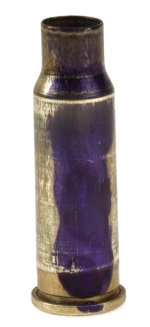
A formed case was painted on one side with Dykem blue, then pushed into more committed contact with the chamber with thumb pressure. Extracted and examined, bright marks indicated that it was the case body, rather than the shoulder, that was limiting forward movement into the chamber.
| Location | Case Head ⌀” | Forward Body ⌀” | Shoulder ⌀” |
| Max Spec | 0.379 | 0.369 | 0.368 |
| Actual | 0.376 | 0.372 | 0.369 |
The cold forming dies, and sizer die, were collectively causing the case shoulders to balloon slightly, but expanded the body aft of the shoulders even more significantly. This created an interference fit between the case body taper and the chamber wall taper, preventing the cartridge from moving fully forward in the chamber. Theoretically, the solution would be to slightly push the shoulder and taper aft.
What to do when dies run out of adjustment range…
The 256 Winchester Magnum, Redding, full length and bullet seater die set is supplied with a conventional shell holder. Redding offers an extended shell holder to facilitate use of their trim die, a die I did use. However, use of the extended shell holder also shortens the press stroke with this short cartridge, and puts the press arm in a maximum leverage position when forming.
The problem was that the case neck needed to be pushed back a tad, but the dies were already at cam over adjustment in the press, so I was out of tad adjustment. The easiest way to extend the adjustment range was to remove material from the top surface of the hardened shell holders.
The case would stay in the same height as held in the holder, but the die could be adjusted farther down on the case as desired. A quick pass on the bench belt/disk sander removed 0.030″ +/- from the surface, without weakening the holder’s… holding ability.
| Location | Case Head ⌀” | Forward Body ⌀” | Shoulder ⌀” |
| Max Spec | 0.379 | 0.369 | 0.368 |
| 1.022″ Rim To Shoulder Datum Line |
0.372 |
0.376 |
0.369 |
| 1.018″ Rim To Shoulder Datum Line |
0.377 | 0.366 | 0.364 |
Dies were adjusted to reduce the dimension from back of rim to shoulder datum line from 1.022″ to 1.018″, which resulted in a change in body taper changes indicated above. The loaded cartridge plopped right into the chamber and the cylinder rotated freely in the cylinder frame.
But what about maintaining proper headspace? The headspace is determined by rim thickness, not the the shoulder. Case fire formed in the Blackhawk’s chamber measured 0.023″, 0.005″ longer, as they expanded under pressure to fill the physical space. Not an excessive change and one easily corrected with the sizer die when reloading the brass.
Houston, we have cases
Notice, no reference was made to annealing. That is because there was none. Cases were lubed prior to initial neck forming, then again on final full length sizing. The yield on good brass was 100%. There was no inside/outside neck reaming, even though the neck reducing process suggests the material would thicken. Formed case neck OD measured 0.286″, loaded ammo neck OD was 0.280″, and direct measurement of neck material thickness with a pin micrometer checked 0.010″ – 0.011″. Fired brass necks expanded to 0.286″.
Close examination of fired brass, from handloads, showed no splits anywhere. There were also no internal radial fractures or signs of case head separation. Both all brass and plated cases sized, loaded and shot as well.
I was able to able to go 3 cycles of reloading before annealing as a preventative measure. Beyond that, there was no further annealing as brass began to get rejected for other reasons. Beyond 10 cycles total cycles; oversize primer pockets, neck splits, and just too ugly to go on…
My technique for annealing is to hold the case at midpoint, roll the case in my fingers while heating the neck with a propane torch, then drop the hot case into a tray of cold water, just as my fingers begin to smoke. The trick is to not overheat the case neck and shoulders and remove all tension, or to exceed the kindling point of fingers.
The 256 Winchester Magnum? Why, Joe? Why?
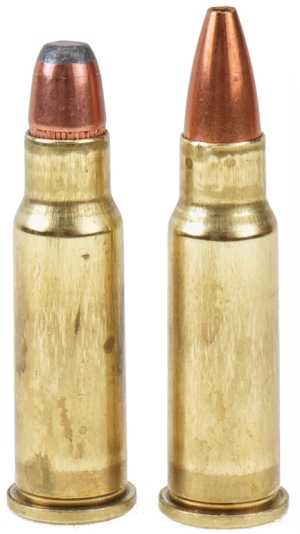 The 256 Winchester Magnum suffered the same fate as numerous other cartridges that were released in advance of a corresponding firearm.
The 256 Winchester Magnum suffered the same fate as numerous other cartridges that were released in advance of a corresponding firearm.
A wave of publicity, results in a wave of interests from enthusiasts, an interest that subsides about the time someone finally ships the first firearm. After all, at that point, the combination is old news and there is no track record of use to sustain popularity.
The 256 Winchester cartridge was announced in late 1961. The Ruger Hawkeye single shot was the first production gun available, 1963-1964. The second was the Marlin Model 62 Levermatic. introduced in 1965. This should tell you a lot.
The Marlin Model 62 was the last in a progression of three short stroke, roller guided breech bolt, Levermatic design firearms.
The Levermatic in the series was a 22 LR that went into production in 1955 and ran until 1964. The second in the series was the Model 57, 1959-1969, in 22 WMR. The final was the Model 62, 1963-1969, chambered in 256 Win Mag and 30 Carbine.
It has been said that it was the non-traditional Levermatic design killed Marlin 256 Winchester sales. However, seeing ten years of production with popular cartridges, it would seem consumers couldn’t see the wisdom in buying a firearm in 256 Win when no other manufacturers were embracing either round. Especially after Ruger withdrew its Hawkeye single shot.
I should not say “No manufacturers” as single shot pistols like the T/C Contender were chambered for the 256 Winchester Magnum. In fact, accessory barrel shops still ship that chamber from inventory. However, there is no factory ammunition, other than what is on the collector’s market. If you want to shoot the 256 Winchester Magnum, you need to create your own ammo.
If you’re shooting a revolver, you have to skip much of the single shot data because it often exceeds maximum cartridge length spec. with heavier weight bullets. The subject Blackhawk cylinder and frame can handle 1.690″ COL, 1.700″ in a pinch. SAAMI maximum cartridge length spec is 1.590″, so the Blackhawk offers something for the handloader to work with.
Cartridge characterization…
The 256 Winchester Magnum is to the 25-20 WCF, what the 375 Winchester is to the 38-55 WCF, and what the 327 Federal is to the 32 H&R Magnum; more powerful, higher operating pressure and slightly altered variations on the same theme… but not exactly, because the 256 Win does not share basic case body dimensions with the 25-20 WCF.
Based on the 357 Magnum, the 256 Winchester body and rim diameter are approximately 0.030″ larger than the 25-20 WCF. At 0.309″, the 256 Winchester’s neck is 0.075″ shorter for increased blown out body capacity, but the 256 Win case length is 0.049″ shorter.
Overall cartridge length for both is the same. At 22 grains, the 256 Win Mag has 3 grains greater capacity. The real performance gain for the 256 Winchester over the 25-20 WCF is its MAP spec of 43 C.U.P. in comparison to the 25-20’s 28 MAP C.U.P. I use past tense because both cartridges have been retired from SAAMI listings.
Both the 25-20 WCF and 256 Winchester Magnum are still active C.I.P. listings. The 256 Winchester Magnum has a Ptmax spec of 3500 BAR and the 25-20 WCF has a spec of 2700 BAR; the equivalent of 50,673 PSI and 39,160 PSI respectively.
Ballistic performance comparisons
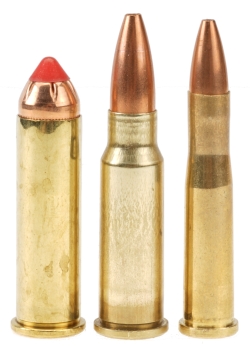 Pictured, L-R: 256 Win Mag parent cartridge 357 Mag, 256 Win Mag, 22 Hornet. The 256 Winchester Magnum is an exceptional short barrel varmint cartridge.
Pictured, L-R: 256 Win Mag parent cartridge 357 Mag, 256 Win Mag, 22 Hornet. The 256 Winchester Magnum is an exceptional short barrel varmint cartridge.
Handgun to comparable handgun, and barrel length, the 256 Win can push a 60 grain bullet as fast as a 22 Hornet can push a 45 grain bullet. The 256 Win can also handle heavier 75 grain bullets in the subject gun without tanking velocity.
There is 256 Win load data utilizing bullets as heavy as 87 grain, however, those are for single shot firearms and with a non-standard cartridge overall length between 1.775″ – 1.825″, which would not work in the Blackhawk.
256 Winchester Magnum Handload Data
Warning: Bullet selections are specific, and loads are not valid with substitutions of different bullets of the same weight. Variations in bullet length will alter net case capacity, pressure and velocity. Primer selection is specific and primer types are not interchangeable. These are maximum loads in my firearms and may be excessive in others. All loads should be reduced by 5% as a starting point for development where cartridges have greater than 40 grains in capacity and 10% for cartridges with less than 40 grain capacity following safe handloading practices as represented in established mainstream reloading manuals. Presentation of these loads does not constitute a solicitation for their use, nor a recommendation.

| Cartridge |
256 Winchester Magnum |
| Firearm | Ruger Blackhawk |
| Barrel Length | 7.5″ |
| Max Case Length | 1.281″ +0.0″/-0.020″ |
| Min- Max COL |
1.540″ Min – 1.590″ Max* |
| Primer | CCI BR-4 Small Rifle |
| Bullet Diameter | 0.2570″ +0.0″/-0.0030″ |
| Reloading Dies | Redding #1&2 Forming and F/L Sizer |
| Max cartridge overall length extended to 1.690″ | |
| Bullet Type | Bullet Weight Grains |
Net H2O Grains Capacity |
COL” | Powder Type | Powder Charge Grains |
MV fps |
ME ft/lbs |
25 Yard 5 Shot Group” |
| Hornady FP | 60 | 19.1 | 1.560 | Hodgdon H110 | 17.0 | 2373 | 750 | 1.6 |
| Hornady FP | 60 | 19.1 | 1.560 | Hodgdon Lil’ Gun | 16.7 | 2325 | 720 | 0.9 |
| Hornady FP | 60 | 19.1 | 1.560 | IMR 4227 | 16.6 | 2014 | 541 | 1.5 |
| Sierra HP | 75 | 17.5 | 1.690 | Hodgdon H110 | 15.2 | 2001 | 667 | 1.3 |
| Sierra HP | 75 | 17.5 | 1.690 | Hodgdon Lil’ Gun | 14.5 | 2097 | 733 | 1.7 |
| Sierra HP | 75 | 17.5 | 1.690 | IMR 4227 | 15.2 | 1903 | 603 | 1.4 |
Notes
The data on the table above is a more evolved version of what appears in Part I. A little more velocity, a little more accuracy. No new powder or bullet types were introduced.
The balancing act with heavier bullets than those noted is between seating depth and bullet form. Cartridge overall length, in this exercise, needs to be less than 1.690″ and not seated so deeply as to place the ogive taper lower than the case mouth.
I was fortunate that case necks had enough tension to hold onto 75 grain jacketed bullets without a cannelure. One reason to not anneal brass unless necessary. Other solutions? I sometimes use a small cannelure tool I purchased from CH Tool & Die about 100 years ago. The current price tag is $134.95. I think I paid… a lot less, but that was then and this is now. As an alternative, a custom factory crimp tool can be ordered from Lee Precision.
Because the recoil is so light, even if the gun makes a bit of a racket, I was able to shoot non crimped ammo without rounds burping up bullets, even if some were left in the cylinder for a couple round trips. I would never try this with a self defense firearm, but for varmint hunting, I would risk the consequence.
What did I take away from this exercise?
There was never an incidence of setback, where a discharged cartridge backed into the breech face and jammed the cylinder.. Shooting the Bowen Classic Arms converted Ruger Blackhawk went without a hitch and was like every other good shooting Blackhawk. Shooting bottle neck cartridges in a revolver in itself is not problematic, unless the cartridge is the 22 Jet, with a body taper like a flying wedge guitar.
The 256 Winchester Magnum Blackhawk was fun to shoot, but I doubt it is an optimal combination. The combination is too light for self defense and medium size game. A need for cannelured bullets, and the pistol’s cylinder’s length, restrict cartridge overall length and, therefore, bullet selection.
By comparison, a single shot, break action pistol does not require a bullet cannelure and crimp, and it can have its chamber throated to accept a longer overall cartridge length. With a maximum length of 1.825″, rather than 1.590″, virtually any 75 grain or 87 grain bullet can be accommodated.
The Ruger Blackhawk remains a terrific firearm and I still hope I will someday own a gun that passed through Bowen Classic Firearms, just in a larger bore.

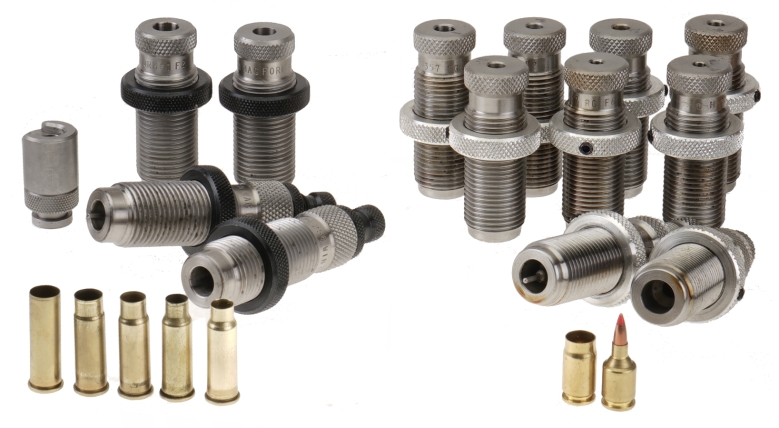
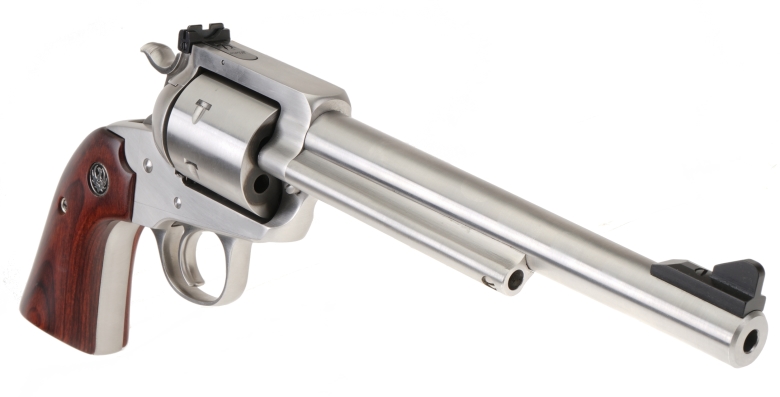
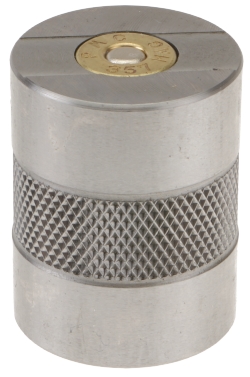
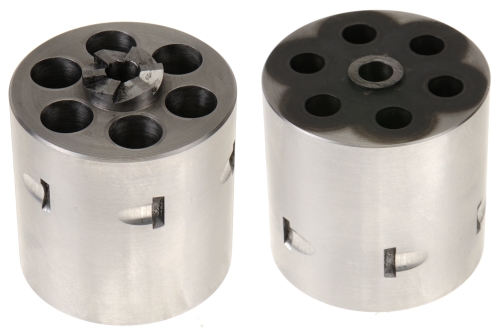
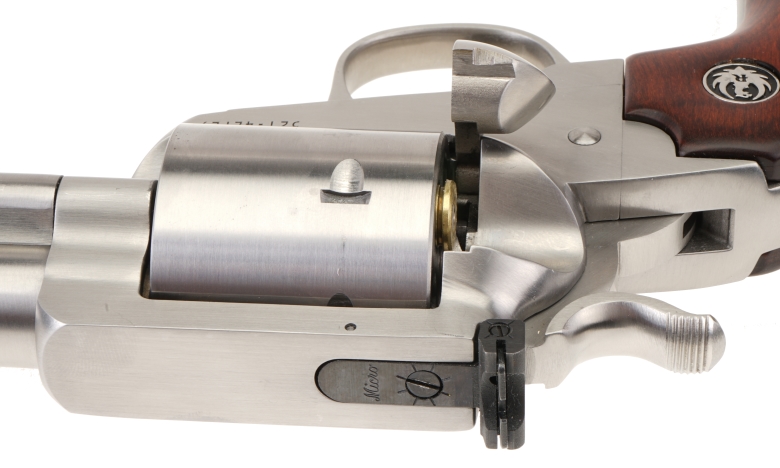
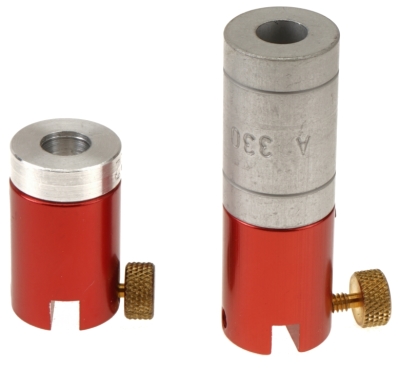
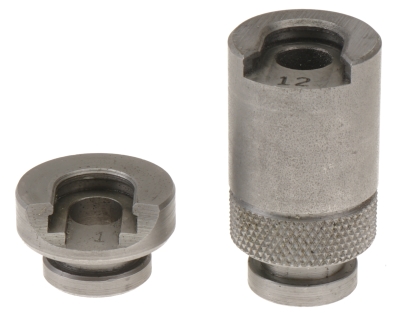

A very interesting article, thanks for taking the time for the finer points.
You’re welcome, Leland.
Agreed, very interesting articles. Cool cartridge, cool gun. Just being fun can be purpose enough. Even unannealed. 😄
As the owner of an MGM barreled Contender rifle in 256, extra interesting. It’s the louder companion to a Stevens 44 in 25-20. Both a very pleasant way to spend an afternoon at the range.
Good barrel for a Contender. The Stevens 44 and BSA Martini are two rifles I would love to own, but never have. Congrats on the Stevens.
Thanks. The Stevens is a neat rifle with the barrel easily unscrewing for takedown travel. It was originally chambered in 25-20 Single Shot and the barrel was set back a full rotation and rechambered in Winchester’s repeater version. Hand loads are kept to SS velocities as it’s not a strong action, unlike the similar 44 1/2 model. Slightly rolling block Vs true falling block driving the strength differences. Wish I had a 44 1/2.
I do have a nice BSA Martini Cadet, which is a wonderful little rifle. Highly recommended. Beautifully made factory adjustable rear sight adds to the appeal.
Thanks for the additional insights on the Stevens, Scott.